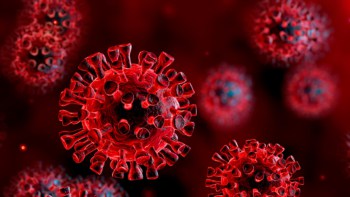
Myxococcus xanthus is a rod-shaped soil bacterium with the ability to move on surfaces. Under starvation conditions, individually migrating bacteria switch their motile behaviour and cooperate to form dome-shaped multicellular structures known as fruiting bodies. The physics behind the creation of these multilayer structures, however, is not well understood.
Intrigued by the densely packed and aligned structure of such M. xanthus colonies, a group of researchers at Princeton University in the US investigated the physics underlying fruiting body formation. The study, published in Nature Physics, reveals that the collective dynamics of migrating bacterial colonies resembles the physics underlying active nematic liquid crystals.
Topological defects in bacterial colonies
To record a wide range of motility-driven collective dynamics of M. xanthus colonies, Katherine Copenhagen at the Lewis-Sigler Institute for Integrative Genomics at Princeton University imaged the colonies using a laser scanning confocal microscope. Copenhagen and group leader Joshua Shaevitz placed the colonies on an agar substrate in the presence of nutrients and, without labelling the cells, used the light reflected from the colony’s surface to measure cell alignment.
Since nutrients were present, no fruiting bodies appeared. However, the researchers observed that new cell layers and holes spontaneously appeared and disappeared. These layers and holes appeared preferentially at points known as topological defects – singularities in the cell orientation field where cells oriented in all directions meet.
These observations motivated the researchers to study this non-equilibrium collective behaviour using the physical framework of active nematic liquid crystals. Active nematics are a class of material made up of elongated particles that align with each other and are able to move on their own – precisely like the bacteria.
To dig into the theoretical physics aspects of active nematics, Ricard Alert at the Princeton Center for Theoretical Science worked with Ned Wingreen to develop a theory for the bacterial colony. Impressively, the experimental data and the theoretical predictions went hand-in-hand.

“A moment that I remember quite vividly,” Alert says, “is watching these videos at the very beginning of this project and starting to realize, wait, do layers form exactly where the topological defects are? Could it be true?” This motivated him to explain the experimental observations via analytical calculations.
“The orientation of rod-shaped particles induced an increased friction from the front to the tail of the defect, leading to cell accumulation at the front and eventually cell extrusion in the third dimension”, explain Marc-Antoine Fardin and Benoît Ladoux from CNRS, in their news and views article for this study.
The researchers propose that cell motility and mechanical interactions between the cells are two key drivers of the formation of multilayered structures. However, since these studies were performed while nutrients were available, future studies under starvation-induced conditions will be important to fully understand the role and characteristics of fruiting bodies.



